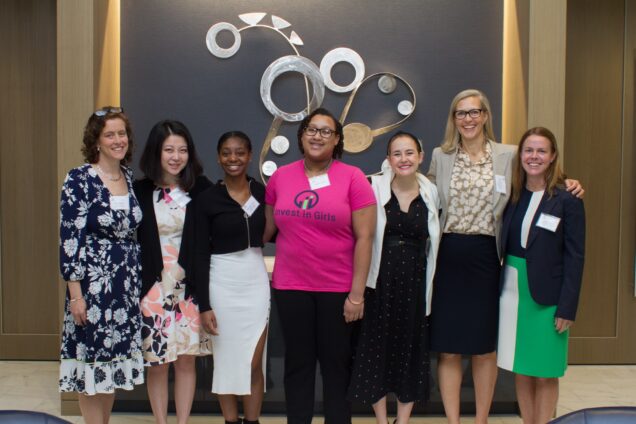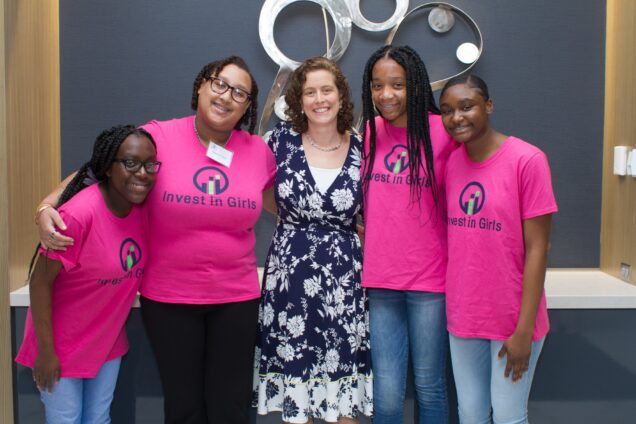Equality Can’t Wait: Financial Literacy Is the Key
by Betsy Kelder
Executive Director, Invest in Girls

Trust Your Gut, Trust the Data
It seems obvious that financial literacy enables young people and adults to make better-informed decisions in their lives than those who are not taught the basics of personal finance. Study after study proves that to be true, including the analysis of current literature by Tim Kaiser, Annamaria Lusardi, Lukas Menkhoff, and Carly Urban published by the Global Financial Literacy Excellence Center (GFLEC) in April 2020: “The evidence shows that financial education programs have, on average, positive causal treatment effects on financial knowledge and downstream financial behaviors.”
Also worth noting, results from the 2018 National Financial Educators Council (NFEC) survey on financial acumen among Americans suggested that insufficient financial literacy cost households more than $295 billion that year. That’s a lot of dollars.
Though reluctant to use the overused phrase “now more than ever,” I will. Now more than ever, while the nation is coping with the effects of a global pandemic, there is also a financial crisis whose scope and impact is yet to be fully understood. For the unemployed and underemployed without a financial safety net, these are truly precarious times. As Carrie Schwab-Pomerantz, President of the Charles Schwab Foundation said, “The pandemic has underscored just how critical basic personal finance skills are in preparing for the unexpected. Financial literacy is a survival skill that everyone needs.” We talk of being able to save for a rainy day… Well, it’s pouring and many people have no umbrella.
The Solution Is Clear: Education and Early Intervention
Learn early and often. “Through financial literacy education, poor financial habits can be eradicated and displaced by more appropriate habits,” according to the nonprofit Financial Educators Council (FEC). And as economist and researcher Annamaria Lusardi recently wrote in Forbes, “Improving financial literacy must be part of the toolkit we use to move forward and be better prepared for the future, for shocks big and small, and to enhance economic opportunities for all.” Agreed!
Financial literacy is crucial to providing for one’s self (or family), planning for the future, and not being taken advantage of by players who would seek to capitalize on uneducated consumers.
The great opportunity we have to combat the troubling statistics that cause unnecessary hardship and adverse outcomes is to introduce concepts of personal finance to students before they make a decision about higher education or enter the world of work; before they apply for their first credit card or think about buying a car. Financial literacy can be thought of similarly to reading literacy—start early with the basics, get a clear understanding of how to sound out the words and put the sentences together, and then move to more advanced and complex books. Would you hand a 4-year-old War and Peace?
By learning about financial literacy while young, students can build good habits around spending and saving, and be better prepared to participate in and benefit from economic opportunities. When we shine a particular light on concepts like budgeting, credit, return on investment, and compound interest when students are in adolescence, we spark an interest and create a firm foundation at a critical time in creating good money habits.
The good news is that the vast majority of Americans believe that standard high school curricula should include financial literacy coursework, according to a 2020 poll by the National Financial Educators Council (NFEC).
But That’s Not All, Folks!
Financial literacy in young women has the potential to drive additional positive results for society, and Invest in Girls, a program of the Council for Economic Education (CEE), is focused keenly on this demographic. And for good reason.
IIG’s mission is twofold: to usher in the first generation of financially literate girls and to increase the number of women working in finance.
Whether living on their own or managing the finances for their family, working or planning for retirement, it’s particularly important for women to be equipped with the knowledge and prowess to make financial decisions that make sense for them. Research shows that investing in women is one of the most effective ways to impact society for the better. And also that a lack of financial confidence keeps women in bad jobs and life situations and precludes them from making some of the decisions that they want to.
In the finance sector, it’s true that progress has been made with regard to gender parity in the field of financial services at the entry-level, but breaking the ever-present glass ceiling, leaning themselves into the C-suite, and serving on boards remains wildly challenging for women.
Invest in Girls teaches tactical skills, builds confidence, and educates about various opportunities in the job market that high school girls can aspire to and apply to when they are ready to join the workforce. IIG offers age-appropriate curriculum and workshops that benefit young women in a number of ways.
Primarily, girls who participate in IIG programming are introduced to basic concepts, such as budgeting and personal finance, the stock market and other investment instruments, taxes, insurance, and philanthropic giving. These learnings will be valuable as they grow up and into their adult lives. In support of their consideration of options for higher education, students are taught about Financial Aid Forms, college loans, and college debt.
Another forward-looking aspect of financial education for girls in high school is centered on the potential for choosing careers in finance. By presenting girls with role models working in finance, connecting them to mentors, giving them exposure to companies and institutions by way of field trips, providing opportunities to network with professionals and peers, and sharpening their interviewing skills, IIG is encouraging young women to see themselves in private equity, financial services, banking, accounting, and portfolio management.
Not only does data prove that diverse teams lead to greater profits, why shouldn’t young women learn the tools of the trade and add their perspective, be it on Wall Street at an investment firm or on Main Street at the branch of a local bank, running a hedge fund or choosing which startups receive venture capital? (They should.)
Invest in Girls partners with independent, charter, and public schools, as well as nonprofit organizations, to provide financial education and opportunities to high school girls across the country. IIG’s outreach includes a focus on attracting students from diverse communities, where teaching financial literacy is a powerful tool for increasing representation in fields that have historically been white and male.

Investing in Girls
In less than 10 years, IIG has grown from 1 program to offering more than 35 successful programs, educating more than 5,000 girls. And we’ve already seen tangible growth since being brought under the aegis of the Council for Economic Education in 2019—a widely respected national organization that fosters the teaching of personal finance and economic education in our nation’s schools. Working with educators, families, and teens already in the CEE network allows for greater reach and scale when it comes to serving communities across the country.
We look forward to a time when it is safe to have after-school classes in person and on-site field trips again, but until that day comes, digital tools have enabled students outside of the northeast region, where IIG was founded, to raise their hands and opt in to the unique programming IIG offers.
The benefits of financial literacy are many. The first generation of financially literate girls will improve outcomes on the personal level, no doubt. Individuals with the knowledge and confidence necessary to run a household who can manage a family’s budget, teach their children the basics of money management, and contribute to society are the base of a stable economy. At the community level, more financially fit women will organically serve as positive role models as they support local tax bases and businesses.
At the institutional level, by increasing the number of women working in finance, we’ll see greater equality in how investment dollars are allocated, more profitable businesses run by diverse leadership and teams, and—we hope—the gender pay gap becoming a thing of the past.
One can dream that building gender equity in finance and a greater diversity of thought in conference rooms and breakrooms, will result in greater equality for the nation. I’m proud to say that Invest in Girls works toward this goal one classroom, one boardroom, and one click at a time.